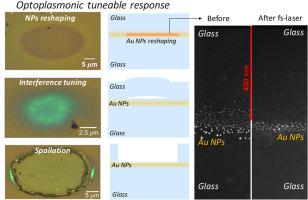用飞秒激光辐照深植入金纳米粒子的玻璃,实现光电可调响应
IF 8.2
2区 材料科学
Q1 MATERIALS SCIENCE, MULTIDISCIPLINARY
引用次数: 0
摘要
操纵等离子纳米复合材料的光学特性,对于开发具有定制独特特性的先进光学设备具有重要意义。要实现这些目标,需要将合成技术和后加工策略相结合。在这里,我们结合使用了两种成熟的物理策略:MeV 离子注入和飞秒激光加工。首先,我们通过离子束植入(1.8 MeV 的 Au2+)合成掺金钠钙玻璃纳米复合材料,然后进行热退火。这一合成过程产生了一种奇特的光学响应,其基础是金纳米粒子质子共振与法布里-珀罗干涉的结合,而法布里-珀罗干涉是由深度植入(以 480 纳米为中心)引起的。其次,通过非共振飞秒激光照射(波长 800 纳米,脉冲持续时间 130fs),证明了这种双重响应的高度可调性。根据激光流率的不同,可区分出三种转变机制:通过剥落烧蚀抑制干涉响应,通过表面膨胀诱导鲜艳的蓝色,以及通过低流率下的多射辐照产生红移颜色变化。所提出的方法非常灵活,因为它适用于任何电介质基体或植入元件。这项工作为开发可扩展、可调整的纳米复合材料铺平了新的道路,在光学领域具有多种潜在应用。本文章由计算机程序翻译,如有差异,请以英文原文为准。

Optoplasmonic tuneable response by femtosecond laser irradiation of glass with deep-implanted gold nanoparticles
The manipulation of the optical properties of plasmonic nanocomposites is of high interest for the development of advanced optical devices with tailored unique properties. Achieving these objectives requires a combination of synthesis techniques and post-fabrication strategies. Here, we combine the use of two well-established physical strategies: MeV ion implantation and femtosecond laser processing. Firstly, we synthesize Au-doped soda lime glass nanocomposite through ion beam implantation (Au2+ at 1.8 MeV) followed by thermal annealing. This synthesis procedure results in a peculiar optical response based on the combination of Au-nanoparticle plasmonic resonance and a Fabry-Perot interference, caused by the deep implantation (centered at 480 nm). Secondly, this dual response is demonstrated to be highly tuneable by non-resonant femtosecond laser irradiation (800-nm wavelength and 130-fs pulse duration). Depending on the laser fluence, three transformation regimes are distinguished: supressing the interferometric response by spallative ablation, inducing vivid blue colors by surface swelling, and producing red-shifted color changes by multi-shot irradiation at low fluences. The proposed method is very versatile, since it is applicable to any dielectric matrix or implanted element. This work paves the way to a new route for the development of scalable and tuneable nanocomposites with several potential applications in optics.
求助全文
通过发布文献求助,成功后即可免费获取论文全文。
去求助
来源期刊

Materials Today Nano
Multiple-
CiteScore
11.30
自引率
3.90%
发文量
130
审稿时长
31 days
期刊介绍:
Materials Today Nano is a multidisciplinary journal dedicated to nanoscience and nanotechnology. The journal aims to showcase the latest advances in nanoscience and provide a platform for discussing new concepts and applications. With rigorous peer review, rapid decisions, and high visibility, Materials Today Nano offers authors the opportunity to publish comprehensive articles, short communications, and reviews on a wide range of topics in nanoscience. The editors welcome comprehensive articles, short communications and reviews on topics including but not limited to:
Nanoscale synthesis and assembly
Nanoscale characterization
Nanoscale fabrication
Nanoelectronics and molecular electronics
Nanomedicine
Nanomechanics
Nanosensors
Nanophotonics
Nanocomposites
 求助内容:
求助内容: 应助结果提醒方式:
应助结果提醒方式:


